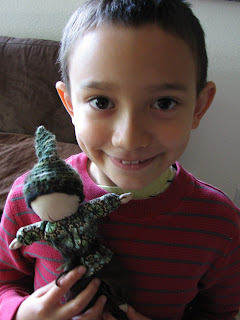"Little Ones" are small Waldorf dolls, made for all children in Grade K at Davis Waldorf School. The classroom angel lets children know that the Little Ones will arrive, and when they do...it's magic!
Our son Wilson, along with other children who did not attend Grade K at the school, had the opportunity to receive a Little One in Grade 1 or 2. The amazing K teacher made the cloth body out of tea-dyed cotton with a blessing flower petal inside. Parents secretively met each week late at night to sew the clothes, felt the hair and make the hats out of cloth, felt or yarn. The Little Ones look similar to the child, and the colors and designs are chosen to match or balance the temperament. They come from "Little Land", and children hold them often while at school and home.
Wilson's "Little One" appeared this morning in his room. His name is "Elf Star", and Wilson wants to call him "Elfie". We are going to make a sleeping bag out of naturally-dyed felt for Elfie so that he may sleep close to Wilson at night.














